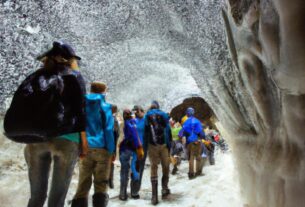As I step onto the soft, golden sand, a tranquil feeling washes over me. The sound of crashing waves and the salty scent of the ocean instantly transport me to a place of relaxation. Sand beaches are not just picturesque, they are also a natural wonder that attract tourists and locals alike. In this article, we’ll delve into the allure of sand beaches, unraveling what makes them so special and why they are crucial for tourism and recreation.
What Makes Sand Beaches So Unique?
A sand beach is a stretch of land along the shoreline composed of sand-sized particles. These particles can originate from a variety of sources such as coral, shells, or rocks. Throughout the world, sand beaches exhibit remarkable differences in color, texture, and size. Some of the most iconic sand beaches include Bondi Beach in Australia, Waikiki Beach in Hawaii, and Copacabana Beach in Brazil.
The Role of Sand Beaches in Tourism and Recreation
Sand beaches are not only aesthetically pleasing, but they also serve as an essential resource for tourism and recreation. They provide a haven for relaxation, swimming, sunbathing, and engaging in various water sports. Tourists flock to these sandy paradises for vacations, honeymoons, and weekend getaways. In fact, according to a report by Zion Market Research, the global beach tourism market is projected to reach a staggering $9.5 billion by 2024.
However, sand beaches are not solely reserved for tourists. They offer valuable resources for local communities as well. Many people use sand beaches for exercising, such as jogging or practicing yoga. Sand beaches also provide a habitat for wildlife, including shorebirds and sea turtles. Additionally, they act as a natural barrier against storms and erosion, safeguarding coastal communities from potential damage.
The Secrets Hidden Within Sand Beaches
Unveiling the Distinctive Traits of Sand Beaches
The characteristics of sand beaches vary depending on the factors influencing their formation. These factors give rise to an assortment of shapes, sizes, and textures that make each sand beach unique.
Types of Sand Beaches
There are three main types of sand beaches – white sand beaches, black sand beaches, and red sand beaches. White sand beaches, comprised of quartz, reflect sunlight, giving them their vibrant appearance. Black sand beaches, on the other hand, consist of weathered volcanic rock, imparting them with a dark, almost black color. Red sand beaches owe their reddish hue to the oxidation of iron-rich minerals.
Factors Influencing Sand Beach Formation
Sand beaches form as a result of various factors, including geology, climate, and ocean currents. The type of rock in the surrounding area affects the sand’s color and texture. For example, coral reefs create white sand beaches, while volcanic activity produces black sand beaches. Climate, including wind patterns and rainfall, influences the amount of sand deposited on the beach. Over time, ocean currents shape the beach, crafting unique formations such as sand dunes or coves.
The Role of Waves in Sculpting Sand Beaches
Waves play a pivotal role in shaping sand beaches. Continual movement of sand particles by waves redesigns the beach over time. High-energy waves, like those during a storm, erode the beach, creating steep cliffs or narrow strips of sand. Conversely, low-energy waves deposit sand, crafting wide, gentle slopes. This ceaseless wave motion sculpts sand beaches, resulting in their characteristic shapes and textures.
The Bountiful Benefits of Visiting a Sand Beach
Are you craving a little vitamin sea? Paying a visit to a sand beach brings numerous physical and mental health benefits. Let’s explore some compelling reasons why you should consider spending your time at the beach.
Health Benefits of Time Spent at the Beach
Did you know that spending time at the beach can positively impact your physical health? The sun’s rays provide essential vitamin D, promoting strong bones and a healthy immune system. Walking or running on the sand offers a more challenging workout compared to a flat surface.
Moreover, the saltwater and sand provide natural exfoliation for your skin, leaving it feeling revitalized and supple. And let’s not forget the tremendous benefits of taking a break from the stresses of daily life. Simply relaxing on a sun lounger or floating in the ocean can do wonders for your mental health and overall well-being.
A Plethora of Recreational Activities at Sand Beaches
Sand beaches offer a plethora of recreational activities suitable for all ages. Delve into swimming, surfing, or snorkeling, which provide thrilling and invigorating workouts. For those who prefer land-based activities, beach volleyball, frisbee, and even yoga classes are available.
Many beaches also offer equipment rentals for kayaks or paddleboards, enabling you to explore the ocean at your leisure. And let’s not overlook the timeless beach pastime of building sandcastles – a delightful activity for both children and adults.
The Therapeutic Effects of Nature
Last but certainly not least, we can’t underestimate the therapeutic effects of nature. Research shows that spending time in nature can lower stress levels, enhance mood, and boost creativity. The sounds of the waves, the sensation of the sand, and the sight of the vast ocean all work together to provide a calming and rejuvenating experience for our minds and bodies.
The Challenges Confronting Sand Beaches
Sand beaches are not merely idyllic retreats for relaxation and recreation. They constitute important ecosystems, playing host to wildlife and serving as a crucial barrier against storms and erosion. Nevertheless, sand beaches face several challenges that jeopardize their long-term viability.
Pollution and Littering
Pollution and littering pose significant threats to sand beaches. Debris and trash can wash up on shore, destroying the beach’s natural beauty and harming wildlife. Plastic is particularly hazardous, as marine animals can mistake it for food or become entangled in it. Littering also leaves behind food wrappers, cigarette butts, and other forms of trash, further polluting the beach environment.
To combat these issues, many local communities have initiated beach cleanup programs, encouraging volunteers to restore the beach’s pristine state by removing trash and debris. Additionally, some beach communities have implemented fines for littering or have banned certain items, such as plastic bags or straws.
Climate Change and Sea-Level Rise
Climate change and the subsequent rise in sea levels present a grave challenge to sand beaches. Increasing global temperatures lead to rising sea levels, resulting in more frequent and severe storms. Consequently, erosion and damage to sand beaches become more prevalent.
To confront this challenge, numerous communities invest in beach nourishment programs, replenishing eroded beaches with additional sand. Some communities also install sea walls or other structures to guard against storm surges and sea-level rise.
Overcrowding and Environmental Impacts
Overcrowding and environmental impacts present another challenge for sand beaches. As tourist numbers surge, beaches become overcrowded, leading to environmental consequences like trampled sand dunes, harmed vegetation, and disturbed wildlife. Moreover, the influx of visitors strains local resources, such as water and waste management.
To address this issue, some communities implement measures to limit the number of visitors to popular beaches. These measures can include timed entry or parking reservations. Furthermore, communities invest in sustainable tourism practices, such as adopting renewable energy solutions or implementing water conservation programs.
Best Practices for Enjoying a Sand Beach Responsibly
When visiting a sand beach, it is essential to be mindful of the environment and take steps to ensure a safe and enjoyable experience for all. Here are some best practices to consider:
Respect for the Environment and Wildlife
Sand beaches are home to diverse wildlife such as shorebirds and sea turtles. It is vital to respect their habitat and avoid disturbing them. Here are some tips to keep in mind:
- Don’t litter: Always dispose of trash properly and refrain from leaving any litter on the beach.
- Avoid disturbing the sand: Refrain from digging or building structures in the sand, as these activities can damage the habitat of beach-nesting birds and turtles.
- Don’t remove shells or coral: Shells and coral contribute to the beach ecosystem, and their removal can harm the habitat.
Safety Precautions for Swimming and Sunbathing
While sand beaches provide excellent opportunities for swimming and sunbathing, safety should be a priority. Here are some tips for a safe experience:
- Swim within designated areas: Many beaches have designated swimming zones. It is advisable to stay within these areas and avoid venturing too far out.
- Follow safety signs: Pay attention to safety signs and flags, as they provide crucial information about hazards such as strong currents or dangerous marine life.
- Protect your skin: Wear sunscreen and seek shade during the hottest parts of the day to safeguard against sunburn and heat-related issues.
Embrace Sustainable Tourism Practices
Sand beaches are invaluable resources, and it is vital to practice sustainable tourism to preserve their health and beauty for the future. Here are some tips to consider:
- Use eco-friendly products: Avoid using products containing harmful chemicals that can pollute the water and harm the environment.
- Reduce your carbon footprint: Consider using public transportation or walking instead of driving to the beach to minimize your impact on the environment.
- Respect local customs: Be respectful of local customs and traditions, refraining from engaging in activities that may be harmful or disrespectful to the local community.
By adhering to these best practices, you can ensure that your visit to a sand beach is safe, enjoyable, and sustainable. Let’s all contribute to the preservation of these natural wonders for generations to come.
Conclusion: Embrace and Protect the Enchanting Sand Beaches
In conclusion, sand beaches stand as both a picturesque spectacle and a vital resource. They attract tourists from around the globe and offer locals a sanctuary for relaxation and enjoyment of the outdoors. However, it is crucial to protect these beaches from pollution, climate change, and overuse. By embracing sustainable tourism practices and respecting the environment, we can ensure that future generations will relish the beauty and value of sand beaches for years to come.
As a nature-focused website, TooLacks encourages everyone to appreciate and safeguard our natural wonders. Whether it is a sand beach, a forest, or a mountain range, let’s all play a role in preserving the environment for future generations. Remember, the next time you visit a sand beach, take a moment to marvel at its beauty and reflect on the significance of safeguarding our planet. Together, we can make a difference.
For more information on nature’s wonders and sustainable living, visit TooLacks.



